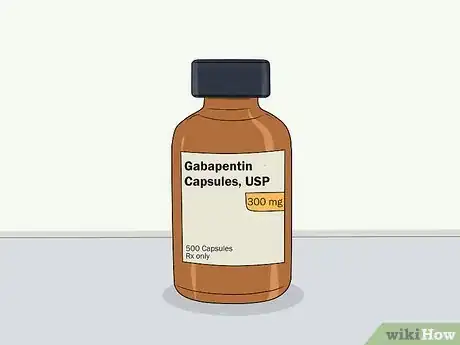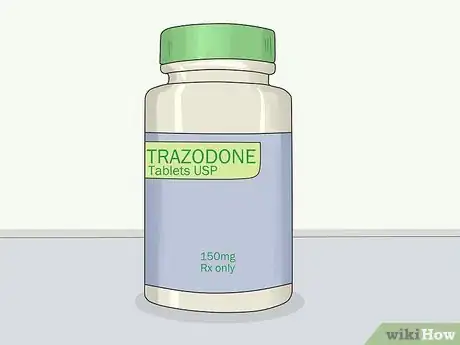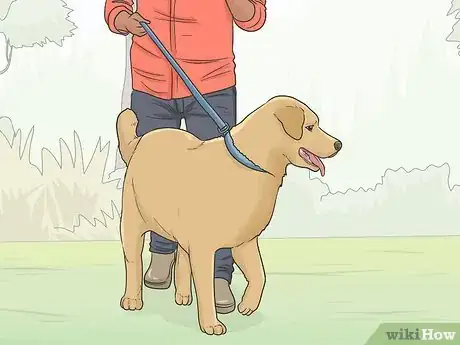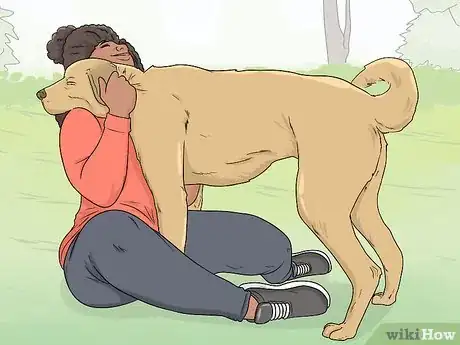This article was co-authored by Jamie Freyer, DVM. Dr. Jamie Freyer is a Licensed Doctor of Veterinary Medicine based in Washington. With over ten years of experience in clinical practice and industry, she specializes in veterinary medicine and surgery, animal behavior, and animal genetics. Dr. Freyer holds a BS in Life Science from The University of Portland and a DVM from Oregon State University.
There are 9 references cited in this article, which can be found at the bottom of the page.
This article has been viewed 142,059 times.
Sedating your dog at home is sometimes necessary for medical or grooming purposes. However, it’s important to consult your dog’s veterinarian first to find the best way to go about it. There are many prescription sedatives available that you can administer at home, or you could try an over-the-counter or natural alternative. If your dog’s anxiety is chronic or severe, you might also want to try some alternative strategies. No matter what you decide to do, make sure to follow up with your dog’s veterinarian to ensure that the sedation strategy you’re using is safe and appropriate for your pet.
Steps
Administering Prescription Sedatives
-
1Talk with your veterinarian if you notice signs of anxiety in your dog. Dogs can become anxious for a variety of reasons, like being around new people, being left alone, or hearing loud noises. If you’ve noticed that your dog has been anxious recently, or if it has been an ongoing problem, make an appointment with your veterinarian to have your dog evaluated and find ways to address the anxiety at home. Some of the ways that anxiety may manifest include:[1]
- Drooling
- Panting
- Urinating or defecating in the house
- Aggressive behavior
- Excessive barking
- Pacing
- Restlessness
- Depressed behavior
- Repeated or compulsive behavior
-
2Ask about acepromazine for a fast-acting sedative.[2] This is a strong, fast-acting sedative that your dog’s veterinarian may prescribe if you need to sedate your dog in a hurry since it works within 20-30 minutes of administration. The medicine typically comes in the form of tablets or a liquid that you can squirt in between your dog’s gums and cheek. Your dog’s veterinarian will likely prescribe a dose of 1-2 mg per 1 kg (2.2 lb) of body weight. However, follow your veterinarian’s specific dosing instructions for your dog.[3]
- There’s also an injectable form of this medication, but this is not something you’d use at home. Your dog’s veterinarian might use it if they needed to sedate your dog for an examination or procedure.
- Only use ACP prescribed by a vet after they perform a thorough assessment of your dog.[4] ACP may not be suitable for all dogs since it can lower blood pressure and some breeds may have an intolerance that could make them aggressive.
- If you have a flat-faced dog breed, they may have an exaggerated reaction to ACP, which may include collapse.
- If your dog is already agitated, anxious, or distressed, ACP may increase their symptoms rather than relieving them.
- Test using ACP beforehand if you plan on sedating your dog during travel to see if it works properly or causes hyper-excitement.
- Avoid using ACP on dogs during fear-inducing events, like thunderstorms or fireworks, since it doesn’t prevent them from feeling fear. The dogs will not be able to move, but they will still get distressed.[5]
Advertisement -
3Request gabapentin for something that will also relieve pain. Gabapentin is a sedative and an analgesic, so it can help to calm your dog and relieve pain. If your dog is anxious due to pain, your veterinarian may prescribe this medicine, which comes in a tablet or liquid that your dog can take orally. The typical dosage range is 10-20 mg per 1 kg (2.2 lb) of body weight. The medication takes around 2 hours to take full effect, so plan to deliver the dose 2 hours before your dog will need to be sedated.[6]
- Your dog’s veterinarian may recommend a higher dose for a dog that is difficult to manage and a lower dose to a dog that less difficult to manage or that it is advanced in age.
- You may also need to administer a dose the night prior to when your dog needs to be sedated. Check with your dog’s veterinarian for specific dosing instructions.
-
4Look into Trazodone for a dog with chronic anxiety. Trazodone is a sedative medication that may be helpful if your dog requires sedation regularly, such as before travel, noisy events, or vet appointments. It’s available as a tablet or liquid that you can give to your dog orally. The medication dose is typically 5 mg per 1 kg (2.2 lb) of body weight administered 2 hours before sedation is required. However, follow your veterinarian’s specific dosing instructions.[7]
- You may also need to administer a dose of the medication the night before your dog requires sedation. Check with your dog’s veterinarian to be sure.
-
5Ask about benzodiazepines for a single or short-term use.[8] Benzodiazepines are fast-acting, but they do not last long. If you need to quickly sedate your dog for an occasional veterinary appointment or for grooming purposes, this might be a good option. The typical dose of diazepam for dogs is 1 mg per 1 kg (2.2 lb) of body weight administered orally, but follow your veterinarian’s specific dosing instructions.[9]
Warning: Keep in mind that these medications are highly addictive, so it’s best not to use them regularly on your dog.
-
6Discuss drug combinations with your veterinarian if your dog is difficult to sedate. Talk with your dog’s veterinarian if your dog does not respond to a single sedative. In some cases, more than one tranquilizing agent may be required to keep your dog calm for a veterinary visit or procedure. However, only your veterinarian can prescribe a combination drug. Do not try to combine sedatives on your own to achieve sedation.[10]
Using Over-the-Counter Sedatives
-
1Try Benadryl if your dog is also suffering from allergies. Check with your dog’s veterinarian before giving your dog Benadryl as it may not be advised in certain situations, such as if your dog has a pre-existing health condition or takes a prescription sedative. If your veterinarian says it’s okay, give your dog 2 mg of Benadryl per 1 kg (2.2 lb) of body weight, or follow your veterinarian’s dosing suggestion. Repeat the dose every 4-6 hours while you need to keep your dog sedated.
- Do not exceed a dose of 4 mg of Benadryl per 1 kg (2.2 lb) of body weight every 4-6 hours.[11]
Warning: Over-the-counter medications are not licensed to use on dogs, so they have not been properly tested or had controlled clinical trials on canines. Use these medications at your own risk since they are not recommended by vets.
-
2Give your dog melatonin for a natural, over-the-counter option. This natural supplement that many humans take to help them sleep can be helpful for sedating dogs as well. If your dog weighs less than 5 kg (11 lb), give it 1 mg of melatonin. If your dog weighs 5–15 kg (11–33 lb), give it 1.5 mg. If your dog weighs 15–50 kg (33–110 lb), give it 3 mg. If your dog weighs more than 50 kg (110 lb), give it 5 mg. Administer the dose 2 hours before your dog will need to be sedated.[12]
- For greater effectiveness, administer the first dose the night before your dog requires sedation, then again 2 hours before it requires sedation.
-
3Soak a dog treat in chamomile tea for a mild, natural sedative. Brew a cup of chamomile tea and allow it to cool to room temperature. Then, either allow your dog to drink the tea or soak a dog biscuit in the tea and offer it to your dog. Chamomile tea affects dogs in the same way that it affects humans, so it might help to keep your dog calm.[13]
- This may be a good option if your dog is only mildly anxious and you want to help it settle down for the night or calm it down before a veterinary visit.
-
4Give your dog a low dose of valerian root for a natural sedative. This over-the-counter supplement is available in pill or liquid form, but there is not a standardized dose for dogs. Consult your dog’s veterinarian for a dosage suggestion and to make sure it’s okay to give this medication to your dog before you try it. They may suggest a very low dose and you might need to gradually increase it to find what works for your dog.[14]
- Although the way valerian root works is not fully understood, it seems to function in a way that is similar to benzodiazepines.
Finding Other Ways to Calm Your Dog
-
1Exercise your dog if it’s healthy enough to do so. Going on walks with your dog, throwing its favorite toy in the back yard, or simply playing a game of tug-o-war with it may be enough to help release its anxiety. As long as your dog is not required to rest due to a medical condition, walk and play with your dog for at least 30 minutes every day to help it calm down.[15]
- You could also try taking your dog to a dog park a few times per week so that it can play with other dogs. Just make sure that your dog is up to date on all of its vaccines before taking it to a dog park.
-
2Use positive reinforcement to get your dog used to anxiety triggers. If your dog tends to respond to certain stimuli, such as the doorbell or the sight of a new person, with anxious behavior, you can retrain it to respond in a calm way. The goal is that over time, your dog will become less anxious when it encounters these triggers. When your dog encounters the trigger, distract it and help it to calm down, such as with a favorite toy or petting. Then, praise your dog and give it a treat as a reward for its calm behavior.[16]
- Repeat this each time your dog encounters the stimuli.
-
3Try placing a snug jacket or body wrap on your dog. You can purchase a special anti-anxiety jacket or body wrap that is meant to help calm your dog. Having your dog wear the jacket or wrap during times when they might feel anxious may help to calm them down naturally.[17]
- These products are available in pet stores and from online retailers.
-
4Consult a dog trainer or behavioral specialist for help with severe anxiety. If your attempts to calm your dog don’t seem to be helping, it may be necessary to get professional help. Ask your veterinarian for a referral to a dog trainer or behavioral specialist who has experience working with anxious dogs. They may be able to help give your dog more confidence and reduce their anxiety.[18]
- You may try using Zylkene, which contains a protein from milk that has a naturally calming effect on anxious animals.
- Try diffusing or spraying Adaptil, which is a natural calming hormone for dogs.
Tip: A group dog obedience class may also be helpful, and it would provide your dog with more socialization opportunities. This may be helpful if your dog gets anxious around other dogs or people.
Expert Q&A
-
QuestionWhat sedative is safe for dogs?
 Jamie Freyer, DVMDr. Jamie Freyer is a Licensed Doctor of Veterinary Medicine based in Washington. With over ten years of experience in clinical practice and industry, she specializes in veterinary medicine and surgery, animal behavior, and animal genetics. Dr. Freyer holds a BS in Life Science from The University of Portland and a DVM from Oregon State University.
Jamie Freyer, DVMDr. Jamie Freyer is a Licensed Doctor of Veterinary Medicine based in Washington. With over ten years of experience in clinical practice and industry, she specializes in veterinary medicine and surgery, animal behavior, and animal genetics. Dr. Freyer holds a BS in Life Science from The University of Portland and a DVM from Oregon State University.
Licensed Veterinarian Talk to your vet about trying Zylkene! You can give this to your dog a few days before and after a potentially stressful event, and it will help keep them calm.
Talk to your vet about trying Zylkene! You can give this to your dog a few days before and after a potentially stressful event, and it will help keep them calm. -
QuestionHow do you treat sound sensitivity in dogs?
 Jamie Freyer, DVMDr. Jamie Freyer is a Licensed Doctor of Veterinary Medicine based in Washington. With over ten years of experience in clinical practice and industry, she specializes in veterinary medicine and surgery, animal behavior, and animal genetics. Dr. Freyer holds a BS in Life Science from The University of Portland and a DVM from Oregon State University.
Jamie Freyer, DVMDr. Jamie Freyer is a Licensed Doctor of Veterinary Medicine based in Washington. With over ten years of experience in clinical practice and industry, she specializes in veterinary medicine and surgery, animal behavior, and animal genetics. Dr. Freyer holds a BS in Life Science from The University of Portland and a DVM from Oregon State University.
Licensed Veterinarian Ask your vet about trying Sileo, which is an FDA-approved noise sensitivity medicine for dogs.
Ask your vet about trying Sileo, which is an FDA-approved noise sensitivity medicine for dogs. -
QuestionDoes Adaptil really work?
 Jamie Freyer, DVMDr. Jamie Freyer is a Licensed Doctor of Veterinary Medicine based in Washington. With over ten years of experience in clinical practice and industry, she specializes in veterinary medicine and surgery, animal behavior, and animal genetics. Dr. Freyer holds a BS in Life Science from The University of Portland and a DVM from Oregon State University.
Jamie Freyer, DVMDr. Jamie Freyer is a Licensed Doctor of Veterinary Medicine based in Washington. With over ten years of experience in clinical practice and industry, she specializes in veterinary medicine and surgery, animal behavior, and animal genetics. Dr. Freyer holds a BS in Life Science from The University of Portland and a DVM from Oregon State University.
Licensed Veterinarian It can in some cases! Adaptil can help some dogs feel a little bit calmer and more comfortable.
It can in some cases! Adaptil can help some dogs feel a little bit calmer and more comfortable.
Warnings
- Make sure that you work with your vet to find the best method of sedation for your dog and follow your vet’s instructions for how to use any medication they prescribe.⧼thumbs_response⧽
References
- ↑ https://www.akc.org/expert-advice/health/treating-dog-anxiety/
- ↑ Jamie Freyer, DVM. Licensed Veterinarian. Expert Interview. 8 October 2021.
- ↑ https://www.mspca.org/angell_services/pre-hospital-sedation-options-for-aggressive-and-anxious-dogs/
- ↑ Jamie Freyer, DVM. Licensed Veterinarian. Expert Interview. 8 October 2021.
- ↑ Jamie Freyer, DVM. Licensed Veterinarian. Expert Interview. 8 October 2021.
- ↑ https://www.mspca.org/angell_services/pre-hospital-sedation-options-for-aggressive-and-anxious-dogs/
- ↑ https://www.mspca.org/angell_services/pre-hospital-sedation-options-for-aggressive-and-anxious-dogs/
- ↑ Jamie Freyer, DVM. Licensed Veterinarian. Expert Interview. 8 October 2021.
- ↑ https://www.merckvetmanual.com/pharmacology/systemic-pharmacotherapeutics-of-the-nervous-system/tranquilizers,-sedatives,-and-analgesics
- ↑ http://www.vasg.org/oral_sedation_for_difficult_dogs.htm
- ↑ https://www.akc.org/expert-advice/health/benadryl-for-dogs/
- ↑ https://www.mspca.org/angell_services/pre-hospital-sedation-options-for-aggressive-and-anxious-dogs/
- ↑ https://dogsaholic.com/care/how-to-sedate-a-dog.html
- ↑ https://www.petmd.com/dog/wellness/valerian-root-dogs-does-it-work
- ↑ https://www.akc.org/expert-advice/health/treating-dog-anxiety/
- ↑ https://www.petmd.com/dog/general-health/sedatives-dogs-how-and-when-use-them-safely
- ↑ https://www.petmd.com/dog/general-health/sedatives-dogs-how-and-when-use-them-safely
- ↑ https://www.akc.org/expert-advice/health/treating-dog-anxiety/







































































